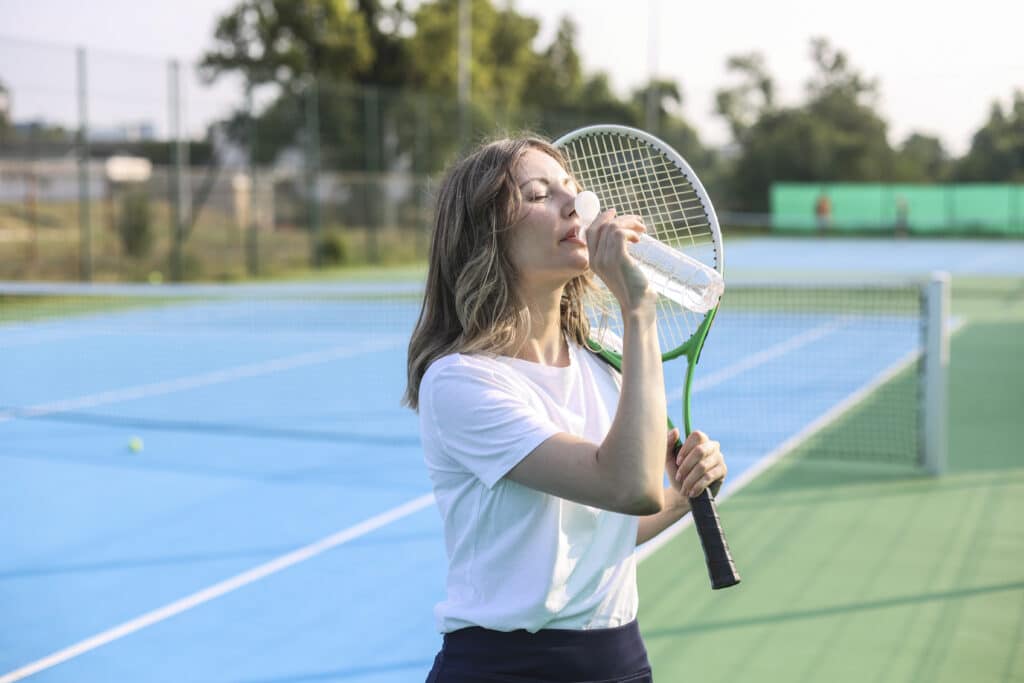
Tennis elbow, medically known as lateral epicondylitis, is a condition that causes pain around the outside of the elbow. It is often the result of repetitive strain and overuse of the forearm muscles, typically affecting athletes, manual laborers, and even office workers who perform repetitive motions. While the causes and treatments of tennis elbow are widely discussed, one aspect that is often overlooked is the role of hydration. Can dehydration exacerbate tennis elbow? This blog post will explore this question and provide insights into how CARESPACE can help manage this condition with a multidisciplinary approach involving physiotherapists and chiropractic doctors.
Understanding Tennis Elbow
Tennis elbow is characterized by inflammation of the tendons that attach the forearm muscles to the lateral epicondyle of the elbow. This inflammation leads to pain and tenderness, especially when lifting or gripping objects. Common symptoms include:
– Pain or burning sensation on the outer part of the elbow
– Weak grip strength
– Discomfort when twisting the forearm
While rest, ice, and over-the-counter medications can provide temporary relief, addressing the root cause is crucial for long-term management.
The Role of Hydration in Musculoskeletal Health
Hydration is essential for overall health, including the maintenance of healthy muscles and joints. Water is a major component of synovial fluid, which lubricates and nourishes joints, facilitating smooth and pain-free movement. Dehydration can lead to decreased synovial fluid production, making joints stiffer and more prone to injury. Moreover, water helps in the efficient removal of metabolic waste from the body. During physical activity, muscles produce waste products like lactic acid, which need to be flushed out to prevent muscle fatigue and soreness. Inadequate hydration can impair this process, leading to increased muscle stiffness and discomfort, which may exacerbate conditions like tennis elbow. The diet also plays a role in tennis elbow. There are some foods you should avoid with tennis elbow in order to help your recovery.
Can Dehydration Worsen Tennis Elbow?
While dehydration alone may not directly cause tennis elbow, it can certainly exacerbate the symptoms. Here’s how:
1. Reduced Synovial Fluid Production: As mentioned earlier, dehydration can decrease the production of synovial fluid, leading to stiffer joints and increased friction in the tendons. This can aggravate the pain associated with tennis elbow.
2. Muscle Fatigue and Stiffness: Dehydrated muscles are more prone to fatigue and stiffness. Since tennis elbow involves the muscles of the forearm, dehydration can make these muscles less flexible and more prone to strain.
3. Delayed Recovery: Hydration is crucial for the body’s healing processes. Dehydration can slow down the recovery of inflamed tissues, prolonging the discomfort and impairment caused by tennis elbow.
Managing Tennis Elbow with CARESPACE
At CARESPACE, we understand that managing tennis elbow requires a comprehensive and personalized approach. Our multidisciplinary team of practitioners, including physiotherapists and chiropractic doctors, works together to create tailored treatment plans that address the root causes of the condition and promote long-term recovery.
The Role of Physiotherapists
Physiotherapists play a crucial role in the management of tennis elbow by:
1. Assessment and Diagnosis: Our physiotherapists conduct thorough assessments to identify the severity of the condition and any contributing factors, such as muscle imbalances or poor ergonomics.
2. Manual Treatment: Techniques like massage, mobilization, and stretching are used to relieve pain, reduce inflammation, and improve the flexibility and strength of the forearm muscles.
3. Exercise Prescription: Personalized exercise programs are designed to strengthen the forearm muscles, enhance flexibility, and prevent future injuries. These exercises also promote proper hydration by encouraging regular physical activity, which naturally increases fluid intake.
4. Education and Advice: Physiotherapists provide guidance on proper hydration, ergonomic adjustments, and activity modifications to prevent overuse and strain.
The Role of Chiropractic Doctors
Chiropractic doctors complement the work of physiotherapists by focusing on the alignment and function of the musculoskeletal system:
1. Spinal and Joint Adjustments: Chiropractic adjustments can improve joint function and reduce nerve irritation, which can help alleviate pain and improve the range of motion in the affected arm.
2. Soft Tissue Treatment: Techniques such as myofascial release and trigger point therapy are used to reduce muscle tension and improve circulation, promoting healing in the elbow region.
3. Posture and Ergonomic Assessments: Chiropractors assess posture and biomechanics to identify any contributing factors to the condition. Recommendations are then provided to improve posture and reduce strain on the forearm muscles.
4. Collaborative Care: At CARESPACE, our chiropractic doctors work closely with physiotherapists to ensure a cohesive treatment plan. This collaborative approach ensures that all aspects of the condition are addressed, providing the best possible outcomes for our clients.
Dehydration can indeed worsen the symptoms of tennis elbow by reducing joint lubrication, increasing muscle stiffness, and delaying recovery. Ensuring proper hydration is a simple yet effective way to support the management of this condition. At CARESPACE, we are committed to providing a holistic and multidisciplinary approach to the treatment of tennis elbow. By combining the expertise of physiotherapists and chiropractic doctors, we create comprehensive and personalized treatment plans that not only address the symptoms but also promote long-term recovery and prevention. If you are struggling with tennis elbow, contact CARESPACE today to learn how our integrated health and wellness services can help you achieve your health goals and live pain-free.




